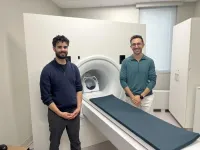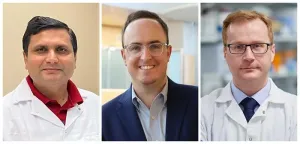(Press-News.org) Two graduate students from Western University have developed a ground-breaking method for predicting which intensive care unit (ICU) patients will survive a severe brain injury.
Matthew Kolisnyk and Karnig Kazazian combined functional magnetic resonance imaging (fMRI) with state-of-the art machine learning techniques to tackle one of the most complex issues in critical care.
Whether it is the result of a stroke, cardiac arrest or traumatic brain injury, lives can forever be changed by a serious brain injury. When patients are admitted to the ICU, families are faced with tremendous uncertainty. Will my loved one recover? Are they aware of what is going on? Will they ever be the same again? Despite these essential questions, health-care professionals are equally uncertain about the potential of a good recovery.
The graduate students are PhD candidates at Schulich School of Medicine & Dentistry in the lab of renowned neuroscientist Adrian Owen.
“For years we’ve lacked the tools and techniques to know who is going to survive a serious brain injury,” said Owen.
An interdisciplinary team of researchers from Western, in collaboration with neurologists at London Health Sciences Centre and Lawson Health Research Institute sought to find a solution to this problem. They were led by Loretta Norton, a psychology professor at King’s University College at Western, who was one of the first researchers in the world to measure brain activity in the ICU.
The team measured brain activity in 25 patients at one of London’s two ICUs in the first few days after a serious brain injury and tested whether it could predict who would survive and who would not.
“We previously found that information about the potential for recovery in these patients was captured in the way different brain regions communicate with each other,” said Norton. “Intact communication between brain regions is an important factor for regaining consciousness.”
The breakthrough occurred when the team realized they could combine this imaging technique with an application of AI known as machine learning. They found they could predict patients who would recover with an accuracy of 80 per cent, which is higher than the current standard of care.
“Modern artificial intelligence has shown incredible predictive capabilities. Combining this with our existing imaging techniques was enough to better predict who will recover from their injuries,” said Kolisnyk.
While encouraging, the researchers say the prediction was not perfect and needs further research and testing.
“Given that these models learn best when they have lots of data, we hope our findings will lead to further collaborations with ICUs across Canada,” said Kazazian.
The study was published in Journal of Neurology.
END
Western researchers use AI to predict recovery after serious brain injury
PhD candidates in neuroscientist Adrian Owen's lab measure brain activity using machine learning
2023-09-13
ELSE PRESS RELEASES FROM THIS DATE:
Flu: Interferon-gamma from T follicular helper cells is required to create lung-resident memory B cells
2023-09-13
BIRMINGHAM, Ala. – During a bout of influenza, B cells interact with other immune cells and then take different paths to defend the body. One path is the B cells that differentiate into antibody producing cells. Another path is the B cells that differentiate into lung-resident memory B cells, or lung-BRMs, that are critical for pulmonary immunity.
Unlike antibody-producing B cells that help fight the current infection, the long-lived, non-circulating lung-BRMs migrate to the lungs from draining lymph nodes. ...
Three University of Oklahoma faculty receive National Institutes of Health funding to maximize their research
2023-09-13
For the first time in one year, three faculty at the University of Oklahoma have received Maximizing Investigators’ Research Awards from the National Institutes of Health.
The recipients are Gallogly College of Engineering faculty Vivek Bajpai, Ph.D., John R. Clegg, Ph.D., and Stefan Wilhelm, Ph.D. The highly competitive five-year, $1,866,485 grants will support their ambitious research programs without the need to recompete for funding throughout the duration of their awards.
Bajpai, an assistant professor in the School of Sustainable Chemical, Biological and Materials Engineering, will lead the project, “Epigenetic and Transcriptional ...
UNIST, DGIST, and POSTECH consortium selected for 2023 ITRC Project in ‘Quantum ICT’ sector!
2023-09-13
The consortium, comprising of UNIST, DGIST, and POSTECH has been chosen for the esteemed 2023 University ICT Research Center Project (ITRC) by the Ministry of Science and ICT (MSIT). This prestigious selection recognizes their expertise in the ‘Quantum Information and Communication Technologies‘ sector. The consortium aims to develop advanced quantum technologies while nurturing exceptional master’s and doctorate-level talents. With a total funding amounting to 8.25 billion won—7.5 billion won from government subsidies—the project spans eight years.
The kick-off meeting held at UNIST on August ...
Human emmisions drive changes in north Atlantic ocean temperatures, west African rainfall, hurricanes
2023-09-13
A new climate study led by scientists at the University Miami Rosenstiel School of Marine, Atmospheric, and Earth Science found that temperature fluctuations in the tropical Atlantic Ocean temperature is largely driven by human-induced aerosol emissions, impacting rainfall in West Africa’s Sahel region and hurricane formation in the Atlantic.
The findings, published in the journal Nature, comes in a year when several hurricanes, including Hurricane Idalia, formed within days of each other over the tropical Atlantic.
“Our ...
WVU engineers study how to pull carbon out of building air to make methanol
2023-09-13
Researchers at West Virginia University have taken the first steps toward developing technology that can capture carbon dioxide in the air and use it for eco-friendly manufacturing of methanol. The process they have begun modeling — which involves pulling air from buildings — could increase the sustainable supply of methanol, one of the world’s most extensively used raw materials, while removing a planet-warming greenhouse gas from the atmosphere.
Project lead Xingbo Liu, who serves as professor, associate dean for research and chair of engineering ...
LSU Health New Orleans study identifies a potential new approach to PTSD treatment
2023-09-13
New Orleans, LA – An LSU Health New Orleans research study led by Siqiong June Liu, PhD, Professor of Cell Biology and Anatomy, has found that cerebellar inhibitory interneurons are essential for fear memory, a type of emotional memory formation. Inhibitory interneurons within the cerebellar circuitry act as gatekeepers and control the output of the cerebellar cortex. The formation of fear memory requires the activity of these interneurons. The findings, which ...
Scientists find good places to grow long-spined sea urchins, a starting point to restore ‘the lawn mowers of the reefs’
2023-09-13
Scientists call long-spined sea urchins “the lawn mowers of the reefs” because they eat algae that could otherwise smother reef ecosystems and kill corals.
That’s why researchers affiliated with the University of Florida Tropical Aquaculture Lab (TAL), who work at the Florida Aquarium’s Conservation Campus in Apollo Beach, are trying to raise as many urchins as possible.
Aaron Pilnick, a post-doctoral researcher at TAL, led newly published research that identifies substrates that help long-spined sea urchins – scientifically known as Diadema -- ...
Could a breakdown in the brain’s networks allow infections to contribute to Alzheimer’s disease?
2023-09-13
The human microbiome includes the genetic material of more than 100 trillion tiny microorganisms – fungi, yeast, bacteria, and even viruses, most of which hang out in our gastrointestinal tract to serve as guardians of our health. But when a healthy microbiome gives way to an imbalance — a “pathobiome” — any number of health problems can occur — from rheumatoid arthritis, to bacterial vaginosis. New data published this month in the journal Frontiers in Cellular and Infection Microbiology, from researchers at Drexel’s College of Medicine, gives more evidence to the possibility that developing a pathobiome ...
Cleaning products emit hundreds of hazardous chemicals, new study finds
2023-09-13
WASHINGTON – A peer-reviewed study by Environmental Working Group scientists has found unsettling details about the potential health risks of common household cleaning products.
The study, published today in Chemosphere, analyzed 30 cleaning products, including multipurpose and glass cleaners, air fresheners and more. The study revealed that these everyday products may release hundreds of hazardous volatile organic compounds, known as VOCs.
Researchers tested both conventional products and “green” cleaning products and detected a total of 530 unique VOCs in the 30 products. Of these, 193 VOCs were hazardous – identified ...
Statement from the European Respiratory Society on results of the European Parliament vote on revision of the Ambient Air Quality Directive
2023-09-13
Professor Zorana Jovanovic Andersen, Chair of the European Respiratory Society’s Environment and Health Committee and based at the University of Copenhagen, said:
“Today’s vote by the European Parliament to strengthen the legally binding limit values for air quality is an important step in the right direction toward clean air for all, even though the full alignment with World Health Organization was moved from 2030 to 2035. As we prepare for the negotiations with the Council, this is great news for all European citizens, especially the millions who live ...
LAST 30 PRESS RELEASES:
Strategic river sensors could have forewarned of Texas Camp flood disaster
Drone sampling of whale breath reveals first evidence of potentially deadly virus in Arctic
Roman soldiers defending Hadrian’s Wall infected by parasites, study finds
Pinochet’s prisoners were tormented with music but still found solace in it, a new book reveals
Fertility remains high in rural Tanzania despite access to family planning
AI-assisted device can improve autism care access
Kinetic careers
Uncovering how parasitic plants avoid attacking themselves to improve crop resistance
Nanoparticle vaccine strategy could protect against Ebola and other deadly filoviruses
Study finds brain care score can predict risk of stroke across racial groups
Key lung immune cells can intensify allergic reactions
Do hormones explain why women experience more gut pain?
New materials conduct ions in solids as easily as in liquids
Breakthrough of the Year: Renewable energy begins to eclipse fossil fuel-based sources
LLM use is reshaping scientific enterprise by increasing output, reducing quality and more
Introducing LightGen, a chip for ultra-fast, ultra-efficient generative AI
Astronomers see fireworks from violent collisions around nearby star
ACC/AHA issue new guideline on managing congenital heart disease in adults
Cosmic crash caught on camera
Is talented youth nurtured the wrong way? New study shows: top performers develop differently than assumed
Ants: An untapped resource in the development of antibiotics?
Archaeologists use AI to create prehistoric video game
Mitochondria migrate toward the cell membrane in response to high glucose levels
Tiny viral switch offers hope against drug-resistant bacteria
Most parents aware of early peanut introduction guidelines, but confused about details
HPV vaccine can protect against severe lesions of the vulva and vagina
Virtual care provision and emergency department use among children and youth
Quadrivalent HPV vaccine and high-grade vulvovaginal lesions
Insights into dry eyes gained from stem cell-derived tear glands
Researchers identify 166 human pluripotent stem cell lines available for use in clinical applications
[Press-News.org] Western researchers use AI to predict recovery after serious brain injuryPhD candidates in neuroscientist Adrian Owen's lab measure brain activity using machine learning






